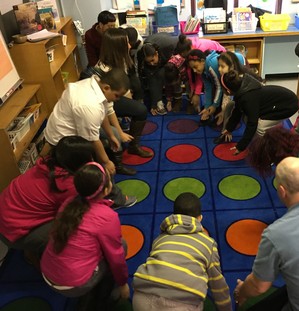During Community-Word Project’s Teaching Artist Training & Internship Program (TATIP), we have learned and practiced creating lesson plans, honed in on our teaching techniques, and studied modules that discuss how information is absorbed. We have then applied what we have learned to teaching for social justice. This especially comes to frution during TATIP’s Teaching for Social Justice seminars.
There are many theories for how people learn and demonstrate intelligence, 3 of which we have especially focussed on during TATIP:
- The Theory of Multiple Intelligences
- Habits of Mind
- The Sternberg Intelligences
The theory of multiple intelligences was developed by the American developmental psychologist Howard Gardner. Gardner divides intelligence into separate modualities, rather than one all-encompassing attribute. He splits the different varieties of intelligence into nine major categories:
- Logical/Mathematical
- Visual/Spatial
- Linguistic
- Bodily-Kinesthetic
- Musical
- Interpersonal
- Intrapersonal
- Naturalistic
- Existential


Habits of mind are problem-solving tactics used by intelligent people to respond to difficult siituations. These were cultivated by Arthur L. Costa and Bena Kallick. Habits of mind include:
- Persisting
- Listening with understanding and empathy
- Thinking about your thinking (metacognition)
- Questioning and problem posing
- Thinking and communicating with clarity and precision
- Taking responsible risks
- Thinking interdependently
- Managing impulsivity
- Striving for accuracy and precision
- Finding humor
I resonate a lot with metacognition. It encompasses being aware of your own thoughts, feelings, and actions, and how that affects others. This is important because teaching for social justice requires the awareness that we have an effect on others, whether we are aware of it or not. It is important to instill this awareness in young people so they can realize the affect they are able to have on the world. These habits of mind are useful in practicing how to integrate cohesively in a society and be a unit. Effective problem solving is vital in this society.
We also learned about the Sternberg Intelligences by Robert Sternberg. He is an American psychologist and psychometrician.
They are:
Analytical, Practical, and Creative.
Analytical: linear, school smart, sequential
Practical: street smart, contextual, focusing on use
Creative: innovator; thinking outside the box, improviser
We can integrate all these types of intelligences, or know when each style is needed. Also knowing which one is our strength, is beneficial.


After learning about these different styles of acquiring knowledge and deminstrating intelligence, we applied them in our Teaching for Social Justice seminars. What I like about Teaching for Social Justice is it reminds us that people learn and are attune in different ways. It is important to know how the youth learn, and how we learn as teaching artists, as well as our strengths and weaknesses. Some students are introverts; others are extroverts. Some get lost being absorbed in a solo project. Some learn by asking big existential questions and coming up with creative solutions or new perspectives for them.
Components of a Strong Lesson Plan:
In TATIP, we also learned one way of creating a lesson plan, by breaking it down into these categories in this order:
Ritual
Intro Activity
Main
Reflection
Closing

A ritual sets the stage for students to transition into a lesson, and rewires and grounds them to be a vessel for what they’re about to learn or take part in.
The intro activity prepares them for the main activity. So, the intro activity should be breaking down certain elements of a bigger topic or introducing them to certain aspects of a main subject. It can take the shape of loosening them up to dive deeper into a main activity.
The reflection is about looking back on what just happened and seeing what students can learn from that; the why’s and discoveries.
The closing grounds the whole lesson in and helps them transition out of the classroom and into the world again, or creates community by coming together to mold the whole activity into completion.
Teaching Path:
During the seminar, we also practiced outlining a Teaching Path. This is a guide to show a prospective employer or employer, what you will be teaching as part of a residency at a school. We break down by date of each class, the theme and short phrase of what we will be doing in class, so that they get a sense of what the season would look like. We introduce the goal, inquiry question, creative elements, skills students will develop, pieces of artwork or artists presented, rituals, and more. The inquiry question serves the same purpose as an objective.
I have been grateful for the opportunity to practice modules for lesson planning, and also discovering more about the mission of Teaching for social justice.



